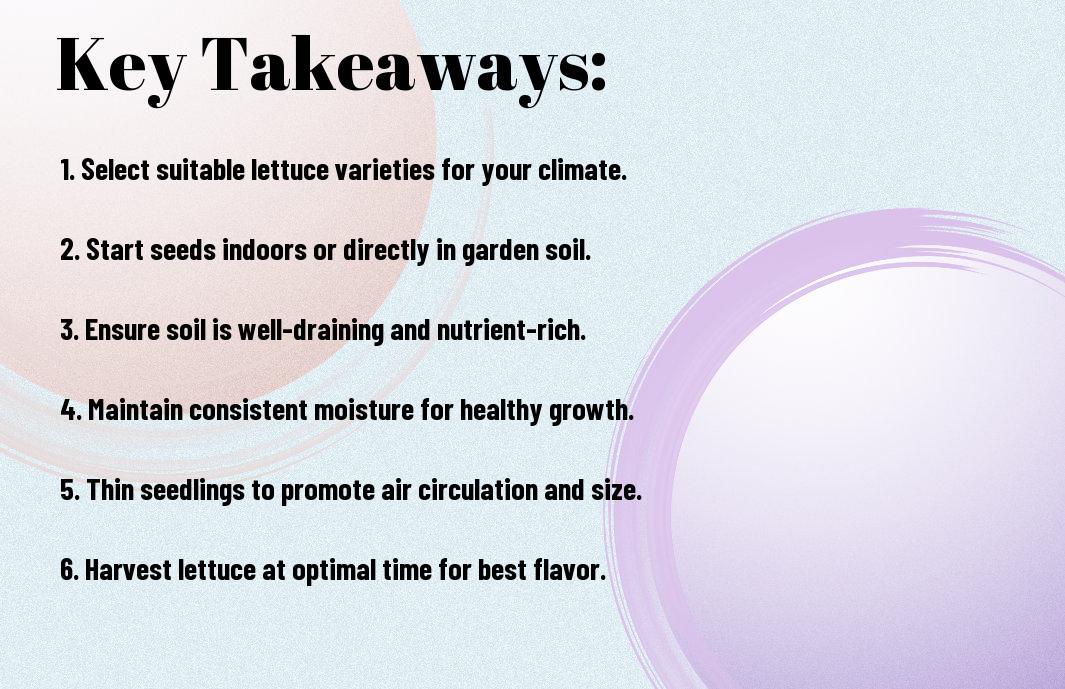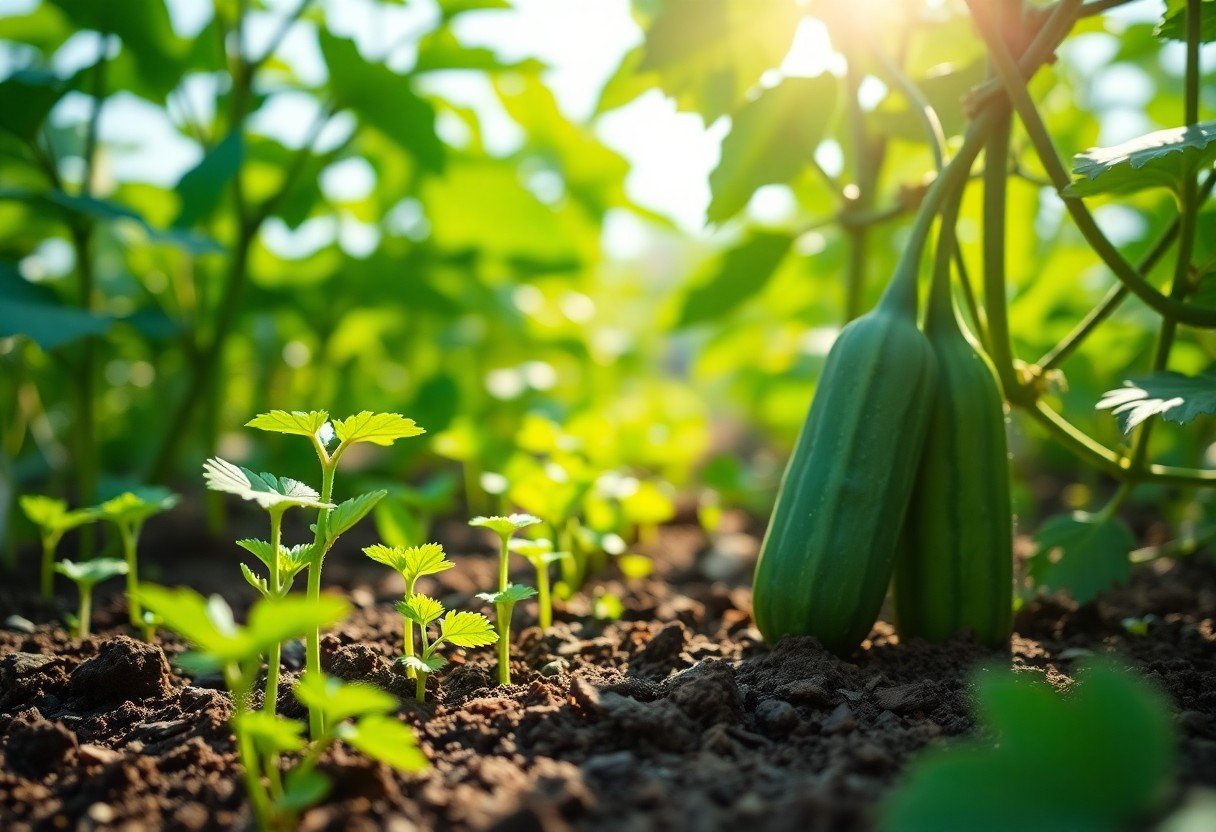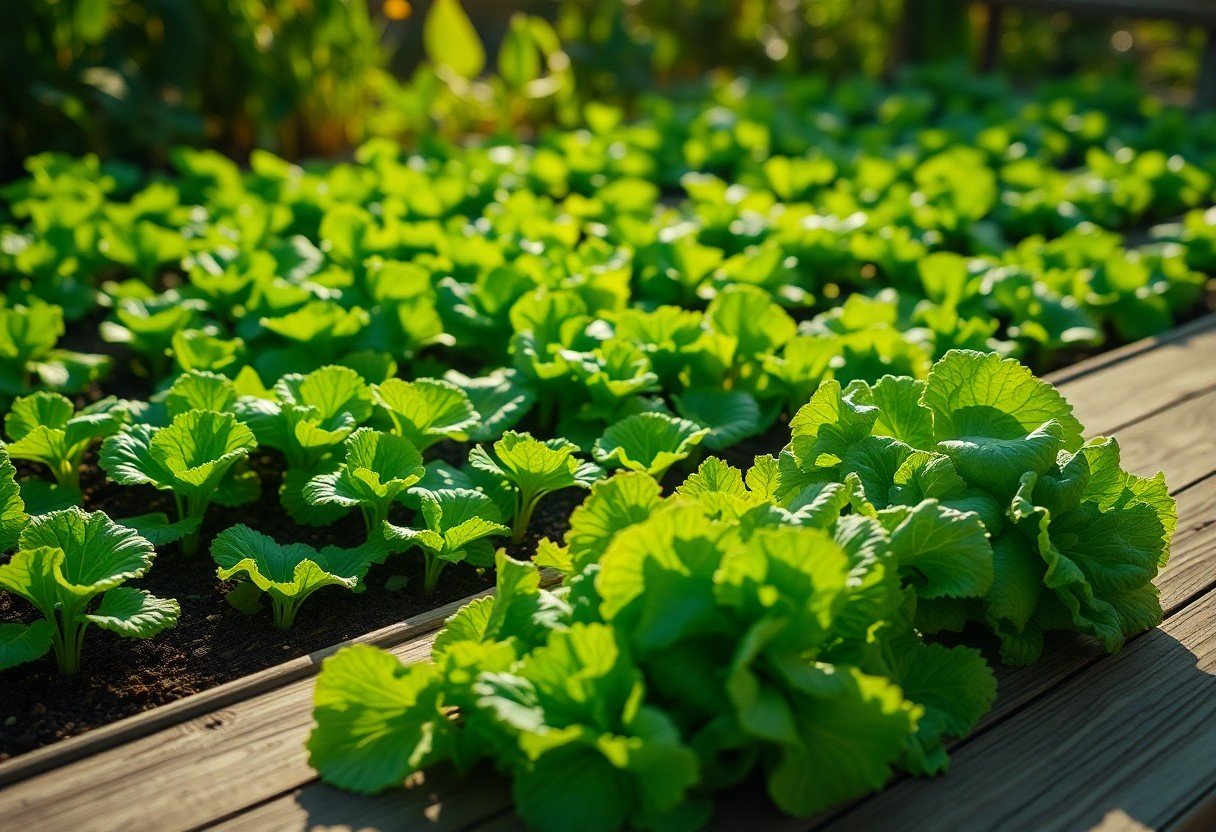Gardening offers you a delightful opportunity to cultivate your own leafy greens, with lettuce being one of the most rewarding options. From selecting the right seeds to providing optimal growing conditions, this guide will empower you to transform simple seeds into vibrant, crisp salads. You’ll learn imperative techniques to nurture your lettuce plants, ensuring you enjoy fresh, homegrown greens all season long. Dive into the world of lettuce gardening and elevate your culinary creations with your very own harvest!

Choosing the Right Lettuce Varieties
Your choice of lettuce varieties can significantly influence the flavor, texture, and overall success of your salads. When deciding on the right type, it’s necessary to consider not only your taste preferences but also the growing conditions in your garden. Lettuce comes in a variety of forms, each with its unique characteristics. Some common options include romaine, butterhead, and leaf lettuce, each offering distinct benefits for your harvest. Below is a breakdown of popular types of leafy greens that are worth considering for your garden.
Types of Leafy Greens
| Type | Description |
| Romaine | Crisp and sturdy leaves, perfect for Caesar salads. |
| Butterhead | Soft and buttery leaves with a mild flavor, great for wraps. |
| Leaf Lettuce | Tender and delicate leaves that grow in a loose rosette; quick to harvest. |
| Iceberg | Crisp and crunchy; offers a refreshing crunch in salads. |
| Mesclun Mix | A mix of various leafy greens, providing diverse flavors and textures. |
- Choose romaine for a sturdy salad base.
- Opt for butterhead for a tender, delicate finish.
- Use leaf lettuce for a quick-growing option.
- Consider iceberg for a refreshing crunch.
- Try mesclun for mixed flavors at your dinner table.
Thou can select the variety that appeals to your palate and suits your garden’s environment.
Seasonal Considerations
Seasonal factors play a significant role when it comes to growing lettuce. Depending on whether you’re in a cooler or warmer climate, certain varieties may thrive better at different times of the year. Generally, lettuce prefers cooler weather, making spring and fall ideal seasons for planting. However, with the right strategies—such as selecting heat-tolerant varieties and providing shade—you can enjoy a continuous harvest even in the summer months.
Greens flourish best when sown at the right time, so understanding your local climate will aid you in timing your planting. For instance, in warmer areas, you might begin planting in late winter or early spring to avoid the intense heat of summer, while cooler regions can start sowing as soon as the soil gets warm enough in spring. Additionally, considering factors like frost dates and selecting the right cultivars can provide a more predictable and rewarding harvest throughout the growing seasons.
Preparing the Soil
Assuming you want to grow lush lettuce, preparing your soil is a vital first step. The right soil composition and quality will set the foundation for vibrant growth, making it necessary to give this aspect the attention it deserves. Lettuce thrives in loose, nutrient-rich soil that allows for ample root development. You’ll want to start with a good mix of topsoil, compost, and well-rotted manure, ensuring that the substrate provides both aeration and fertility. By creating a rich growing medium, you are necessaryly creating a nurturing environment that supports the health of your plants from the very beginning.
Soil Composition and Quality
With the right soil composition in mind, focus on achieving a blend that balances drainage and moisture retention. Ideal lettuce soil should consist of at least 50% organic matter, which can include compost, leaf mold, or peat moss, mixed with sand or perlite for enhanced drainage. This combination fosters a healthy ecosystem that promotes beneficial microbial activity and retains nutrients, allowing your lettuce plants to flourish. Before planting, thoroughly mix these components to create a uniform texture, ensuring that every seed has optimal conditions to germinate and grow.
pH Levels and Nutrients
At this stage of preparation, it is also important to check the pH levels and nutrient content of your soil. Lettuce prefers slightly acidic to neutral pH levels, ranging from 6.0 to 7.0. Using a soil test kit can help you determine the pH and whether amendments are necessary to create the ideal growing environment. Additionally, ensuring that your soil is rich in necessary nutrients, including nitrogen, phosphorus, and potassium, will empower your plants to grow healthy and vibrant. You might consider incorporating organic fertilizers or slow-release supplements to boost nutrient availability.
Understanding the interplay between pH levels and nutrients is vital for the successful growth of your lettuce. If your soil’s pH is too high or too low, it can significantly hinder nutrient absorption, leading to poor growth or deficiencies. By adjusting the pH through natural amendments like sulfur (to lower pH) or lime (to raise pH), you can create the balanced environment your lettuce needs. Regular testing and monitoring of your soil’s health will pay off in the form of crisp, delicious salads harvested from your own thriving garden.

Sowing Seeds
For the successful growing of lush lettuce, the first step begins with sowing seeds. You want to choose high-quality seeds that will germinate consistently and produce healthy plants. The best lettuce varieties for home gardeners include Butterhead, Iceberg, and Romaine. Ensure that you consider your local climate and growing season when selecting your seeds, as some varieties thrive better in cooler weather while others prefer warmer conditions. Fresh, untreated seeds generally have higher germination rates, so keep your selection up to date. Furthermore, proper storage of your seeds is necessary to maintain their viability—store them in a cool, dark place in airtight containers to protect them from moisture and pests.
Seed Selection and Storage
Along with selecting the right lettuce varieties for your garden, proper storage ensures that your seeds remain viable for the planting season. Choose seeds from reputable sources that specialize in organic or heirloom varieties, as these often provide the best flavor and yield. Once you’ve secured your seeds, keep them in a cool, dry environment—consider using a refrigerator or a basement where temperatures remain stable. It’s also a good idea to label your containers with the variety and date of purchase, which will help you track their age and ensure that you use the freshest seeds first.
Planting Techniques
Beside choosing the right seeds, how you plant them can significantly affect their growth. When you’re ready to sow, prepare your soil by loosening it with a garden fork or tiller and mixing in organic matter like compost to enhance fertility. Space your seeds according to the variety’s recommendations and sow them at the optimal depth—generally, lettuce seeds should be placed just under the surface of the soil, as they require light to germinate. Water your newly sown seeds gently to avoid displacing them and cover the area with a light layer of mulch to retain moisture and inhibit weed growth.
Due to the preference of lettuce seeds for cooler soil temperatures, consider timing your sowing for early spring or late summer for a fall harvest. If you desire a continuous supply of fresh lettuce, stagger your sowings every couple of weeks. Modify your sowing techniques based on your environment, whether it’s in rows, clusters, or even direct seeding in the garden. By adopting these strategies, you’ll set your lettuce plants up for a robust growth phase that will lead to crisp and flavorful salads later on.

Watering and Maintenance
Keep in mind that proper watering is the cornerstone of healthy lettuce growth. Lettuce thrives in consistently moist soil, but overwatering can lead to root rot. You should aim to provide about one inch of water per week, either through rainfall or irrigation, to ensure your plants are adequately hydrated. Checking the top inch of soil for moisture can help you determine if it’s time to water. When watering, consider using a drip irrigation system or soaker hoses, which deliver moisture directly to the roots and minimize evaporation.
Irrigation Methods
Above all, the method of irrigation you choose can greatly influence the health of your lettuce. Drip irrigation is highly efficient and ideal for maintaining consistent soil moisture levels without wetting the foliage, which helps prevent diseases. If you prefer to hand water, try to water in the early morning or late afternoon to reduce evaporation. Ensure that you water deeply but infrequently, which encourages the lettuce roots to grow stronger and reach deeper into the soil.
Pest Control and Disease Management
By keeping an eye out for common pests and diseases, you can protect your lettuce crop effectively. Aphids, slugs, and downy mildew are just a few threats to your leafy greens. Regularly inspect the underside of leaves and the soil surfaces for signs of infestations or fungal infections. Using organic pesticides or introducing beneficial insects like ladybugs can help secure your garden against these unwanted visitors.
Hence, integrating preventive measures such as crop rotation and maintaining good garden hygiene can go a long way in promoting robust plant health. Cultivating a diverse garden ecosystem not only supports your lettuce but also encourages natural pest predators. Early detection and management of any issues will save you time and effort down the road, allowing you to enjoy a bountiful harvest of crisp, healthy lettuce.

Harvesting Lettuce
Timing and Techniques
All good things come to those who wait, and harvesting your lettuce is no exception. Timing is crucial; you want to ensure that your lettuce is picked at its peak for maximum flavor and crispness. Generally, you should plan to harvest your lettuce about 30 to 70 days after sowing, depending on the variety. Look for leaves that are fully formed and vibrant green, signaling that they’re ready for your salads.
Above all, choose the right technique for harvesting. You can opt for a “cut-and-come-again” approach, where you snip the outer leaves, allowing the inner ones to continue growing. This method helps extend your harvest period. Alternatively, if your lettuce heads are mature and you prefer a whole-harvest method, use a sharp knife to cut the base of the head just above the soil, ensuring minimal damage to the plant.
Post-Harvest Handling
An crucial part of enjoying your lettuce is what you do after harvesting. It’s best to handle your freshly picked greens with care to maintain their crispness and flavor. Begin by removing any damaged or wilted leaves to enhance overall appearance and freshness. Rinse the lettuce under cool water to remove dirt and pesticides, ensuring that you gently shake off excess moisture. This step will help in keeping your greens crisp until they make it to your table.
Plus, storing your lettuce properly can significantly extend its shelf life. After washing, you can use a salad spinner to remove excess water, then wrap the leaves in a slightly damp paper towel. Place them inside a breathable container or a perforated plastic bag in your refrigerator. Doing this keeps the humidity at bay while maintaining their crisp texture, ensuring that your salads are always fresh and enjoyable.
Creative Ways to Use Lettuce in Salads
Despite being one of the milder greens, lettuce can be a versatile ingredient in your salads. You can elevate your salads by pairing your leafy greens with vibrant ingredients that provide texture, taste, and color. Explore different varieties of lettuce, such as romaine, butterhead, or arugula, and combine them with other vegetables, nuts, seeds, fruits, and proteins. Adding items like grilled chicken, roasted chickpeas, or even seasonal fruits like peaches or strawberries can significantly enhance the flavors in your salad while ensuring it remains nutritious and satisfying.
Flavor Combinations
After stocking your garden with fresh lettuce, you can experiment with flavor combinations that will excite your palate. Think of bold pairings like crisp romaine tossed with tangy feta cheese, sweet cherry tomatoes, and zesty vinaigrette. You can also try incorporating crunchy nuts and seeds, such as walnuts or sunflower seeds, for added texture. For a fusion touch, consider adding Asian ingredients like sesame oil and soy sauce to your salad, combining them with leafy greens for a refreshing twist. Your creativity in flavor combinations can turn a simple salad into a culinary experience.
Salad Recipes
Against the common notion that salads are merely side dishes, embracing lettuce as a main course option opens up a whole new world of culinary possibilities. You can craft hearty salads filled with a variety of necessary nutrients, featuring bases that highlight your fresh lettuce. By integrating proteins like grilled shrimp or marinated tofu, combined with grains like quinoa or farro, you’re constructing salads that not only taste great but also provide fullness and sustainability to your meal. Don’t shy away from bold dressings or toppings, as they can really uplift the overall experience of your salads.
It’s necessary to have a repertoire of salad recipes that cater to different occasions and preferences. Classic combinations like Caesar salad or Caprese salad can serve as a fantastic foundation, while you can also venture into more inventive mixes, such as a taco salad featuring ground turkey, black beans, and corn layered over a bed of crispy lettuce. Consider seasonal ingredients to infuse freshness into your dishes—spring peas and asparagus work beautifully in the spring, while roasted squash and dried cranberries can be delightful in the fall. With a little inspiration, each salad can be a unique and satisfying meal that showcases your lush lettuce and an assortment of flavors.
Conclusion
Following this guide, you now have a solid understanding of how to successfully grow lush lettuce from seed to crisp salads. By selecting the right varieties, ensuring optimal growing conditions, and providing consistent care, you can cultivate an abundant harvest that will elevate your meals. As you gain experience, you’ll discover the subtle nuances in caring for your leafy greens, allowing you to optimize the growth process and ultimately produce the tastiest results for your salads.
Engaging in growing your own lettuce not only nourishes your body but also provides a fulfilling gardening experience. As your seedlings emerge and mature into beautiful heads of lettuce, you’ll feel a sense of accomplishment every time you sit down to enjoy a fresh salad made from your own garden. With patience and practice, you’ll refine your gardening techniques and gain confidence in your ability to grow and harvest a stunning array of leafy greens right in your own backyard.














